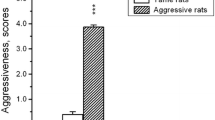Abstract
Indications of a role for the nonpseudoautosomal region of the Y chromosome (YNPAR) in intermale attack behavior have been demonstrated by Maxson's group using C57BL/10 (B10) and DBA/1 (D1) inbred mouse strains and their reciprocal congenics. Carlier and Roubertoux' group, using CBA/H (H) and NZB/B1NJ (N) mice, did not find such a YNPAR effect. For the two research groups, however, not only were the parental strains different, but also the rearing conditions and testing methods. The divergent conclusions drawn may therefore have been due either to genetic variation or to environment-related variables. We carried out two experiments to investigate these alternatives. The N and H strains were raised and tested according to the experimental design used by Maxson's group (homogeneous set test) and the D1 and B10 strains were raised and tested according to the experimental design of Carlier and Roubertoux' group (standard opponent test). Considering all studies together, the YNPAR effect appeared in both sets of mice only when using the homogeneous set test. This raises the question of what environmentally related variables are involved in the YNPAR effect on intermale attack. One strong hypothesis is that the different types of opponents in each experimental design send differing olfactory signals, which, in turn, differentially affect the capacity to elicit intermale attack behavior.
Similar content being viewed by others
References
Brain, P., and Poole, A. (1974). Some studies on the use of “standard opponents” in intermale aggression testing in TT albino mice.Behaviour 50: 100–110.
Carlier, M., and Roubertoux, P.L. (1986). Differences between CBA/H and NZB mice on intermale aggression. In Médioni, J., and Vaysse, G. (eds.),Genetic Approaches to Behavior, Privat, L. E. C., Toulouse, pp. 47–57.
Carlier, M., Roubertoux, P. L., Kottler, M. L., and Degrelle, H. (1990). Y chromosome and aggression in strains of laboratory mice.Behav. Genet. 20:137–156.
Connor, J. (1972). Olfactory control of aggressive and sexual behavior in the mouse (Mus musculus L.).Psychon. Sci. 27:1–3.
Didier-Erickson, A., Maxson, S. C., and Ogawa S. (1989). Differential effect of the DBA1 and C57BL10 Y chromosomes on the response to social or other stimuli for offense.Behav. Genet. 19, 675–683.
Flaherty, L. (1981). Congenic strains. In Foster, H. L., Small, J. D., and Fox, J. G. (eds.)The Mouse in Biomedical Research, Academic Press, New York, pp. 215–222.
François, M. H., Nosten-Bertrand, M., Roubertoux, P. L., Kottler, M. L., and Degrelle, H. (1990). Opponent strain effect on eliciting attacks in NZB mice: Physiological correlates.Physiol. Behav. 47:1181–1185.
Ginsburg, B. E., and Allee, W. C. (1942). Some effects of conditioning on social dominance and subordination in inbred strains of mice.Physiol. Zool. 15:485–506.
Haas, M. C., Roubertoux, P. L., Carlier, M., and Degrelle, H. (1989). Y-chromosome and intermale aggression in mice. II. Use of a marker on the X-Y pairing region (XY-PR).Behav. Genet. 19:762.
Lee, C. T., and Brake, S. C. (1971). Reactions of male fighters to male and female mice, untreated or deodorized.Psychon. Sci. 24:209–211.
MacIntosh Schellinck, H., Monahan, E., Brown, R. E., and Maxson, S. C. (1993). A comparison of the contribution of the major histocompatibility complex (MHC) and Y chromosomes to the discriminability of individual urine odors of mice by Long-Evans rats.Behav. Genet. 3:257–263.
Maxson, S. C. (1992a). Methodological issues in genetic analyses of an agonistic behavior (offense) in male mice. In Goldowitz, D., Wahlsten, D., and Wimer, R. E. (eds.),Techniques for the Genetic Analysis of Brain and Behavior: Focus on the Mouse, Elsevier Amsterdam, pp. 349–373.
Maxson, S. C. (1992b). Potential genetic models of aggression and violence in males. In Driscoll, P. (ed.),Genetically Defined Animal Models of Neurobehavioral Dysfunctions, Birkhäuser, Boston, pp. 174–188.
Maxson, S. C., Ginsburg, B. E., and Trattner, A. (1979). Interaction of Y chromosomal and autosomal gene(s) in the development of intermale aggression.Behav. Genet. 9: 219–226.
Maxson, S. C., Didier-Erickson, A., and Ogawa, S. (1989). The Y chromosome, social signals, and offense in mice.Behav. Neural Biol. 52:251–259.
Michard, C., and Carlier, M. (1985). Les conduites d'aggression intraspécifiques chez la souris domestique. Différences individuelles et analyses génétiques.Biol. Behav. 10:123–146.
Mugford, R. A., and Nowell, N. W. (1970). Pheromones and their effect on aggression in mice.Nature 226:967–968.
Ropartz, P. (1968). The relation between olfactory stimulation and aggressive behavior in mice.Anim. Behav. 16:97–100.
Roubertoux, P. L., Carlier, M., Degrelle, H., Haas-Dupertuis, C., Phillips, J., and Moutier, r. (1994). Co-segregation of intermale agression with the pseudoautosomal region of the Y chromosome in mice.Genetics 136:225–230.
SAS Institute Inc. (1987).SAS/STAT Guide for Personal Computers, Version 6 Edition, SAS Institute, Cary, NC.
Selmanoff, M. C., Maxson, S. C., and Ginsburg, B. E. (1976). Chromosomel determinants of intermale aggressive behavior in inbred mice.Behav. Genet. 6:53–69.
Author information
Authors and Affiliations
Rights and permissions
About this article
Cite this article
Guillot, PV., Carlier, M., Maxson, S.C. et al. Intermale aggression tested in two procedures, using four inbred strains of mice and their reciprocal congenics: Y chromosomal implications. Behav Genet 25, 357–360 (1995). https://doi.org/10.1007/BF02197285
Received:
Accepted:
Issue Date:
DOI: https://doi.org/10.1007/BF02197285



